Learning & Teaching
Learning and Teaching encompasses the following areas: Student Outcomes, Curriculum, Assessment, Reporting, Principles and Pedagogy.

Learning & Teaching
Learning and Teaching encompasses the following areas: Student Outcomes, Curriculum, Assessment, Reporting, Principles and Pedagogy.
Term 3 Reflection
As we end another term, we must stop and reflect on the wonderful learning experiences. I am very grateful for each moment we spent together learning and celebrating. The dedication and commitment of teachers, families, and students have made this term a genuinely enriching experience.
This past term was filled with fun, curiosity, discovery, and countless learning opportunities and community events. Some of our many experiences, opportunities and celebrations this term include:
These excursions, incursions, and celebrations were part of the more extensive teaching and learning programs teachers planned each week for our core subject areas of Literacy, Numeracy, STEM, Sport, Italian, Visual Arts, The Resilience Project, Inquiry, Discovery, and Religious Education.
Our celebration of learning sessions allowed you to see our students' work; they were excited to share and reflect on their knowledge with an authentic audience. I hope you saw some of our fantastic learning at the celebration of learning sessions.
Wishing you a wonderful and safe holiday. STAY WARM!
Here is a video of our term’s celebrations and some photos of the celebration of learning sessions.
Vira
















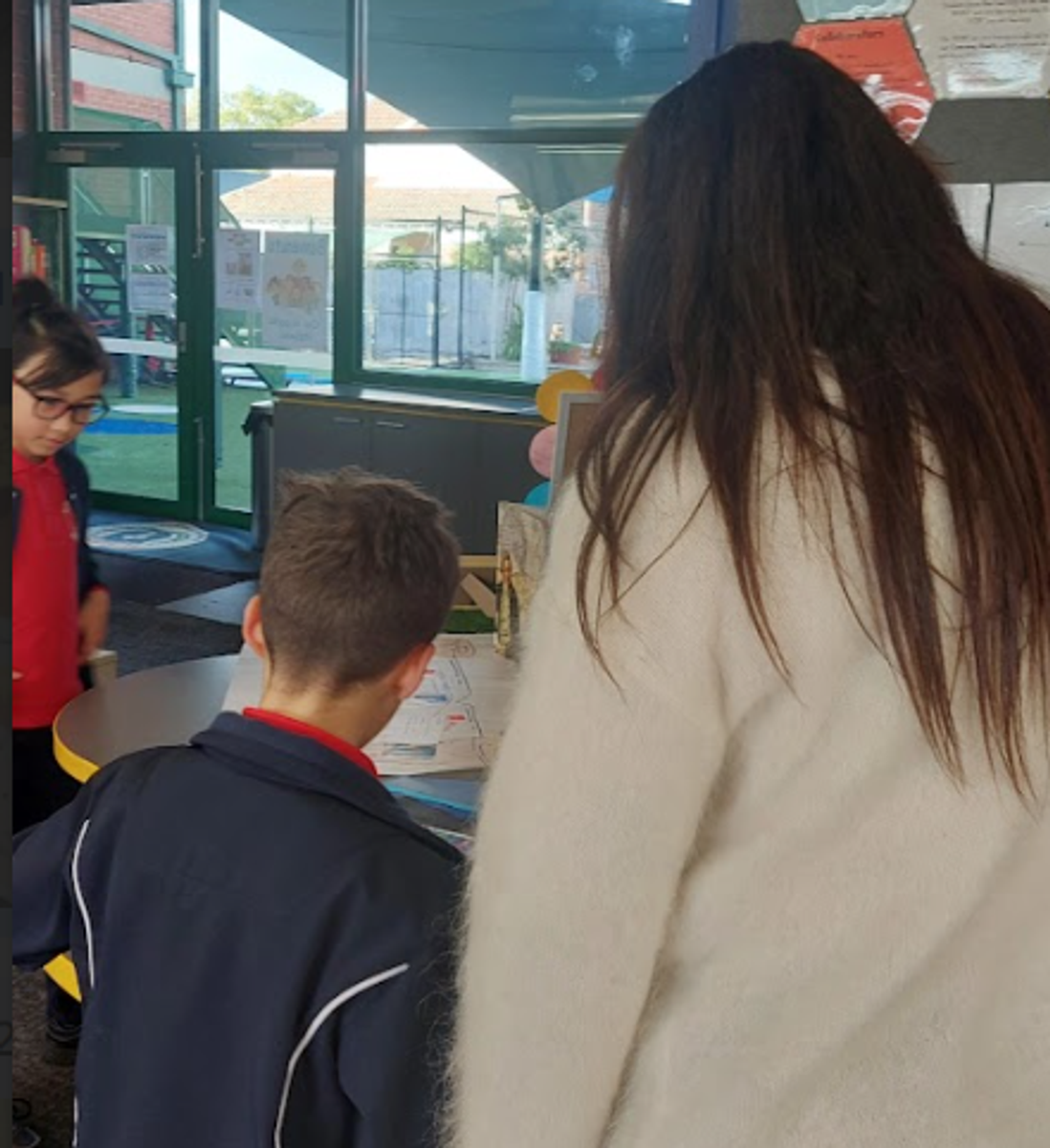





















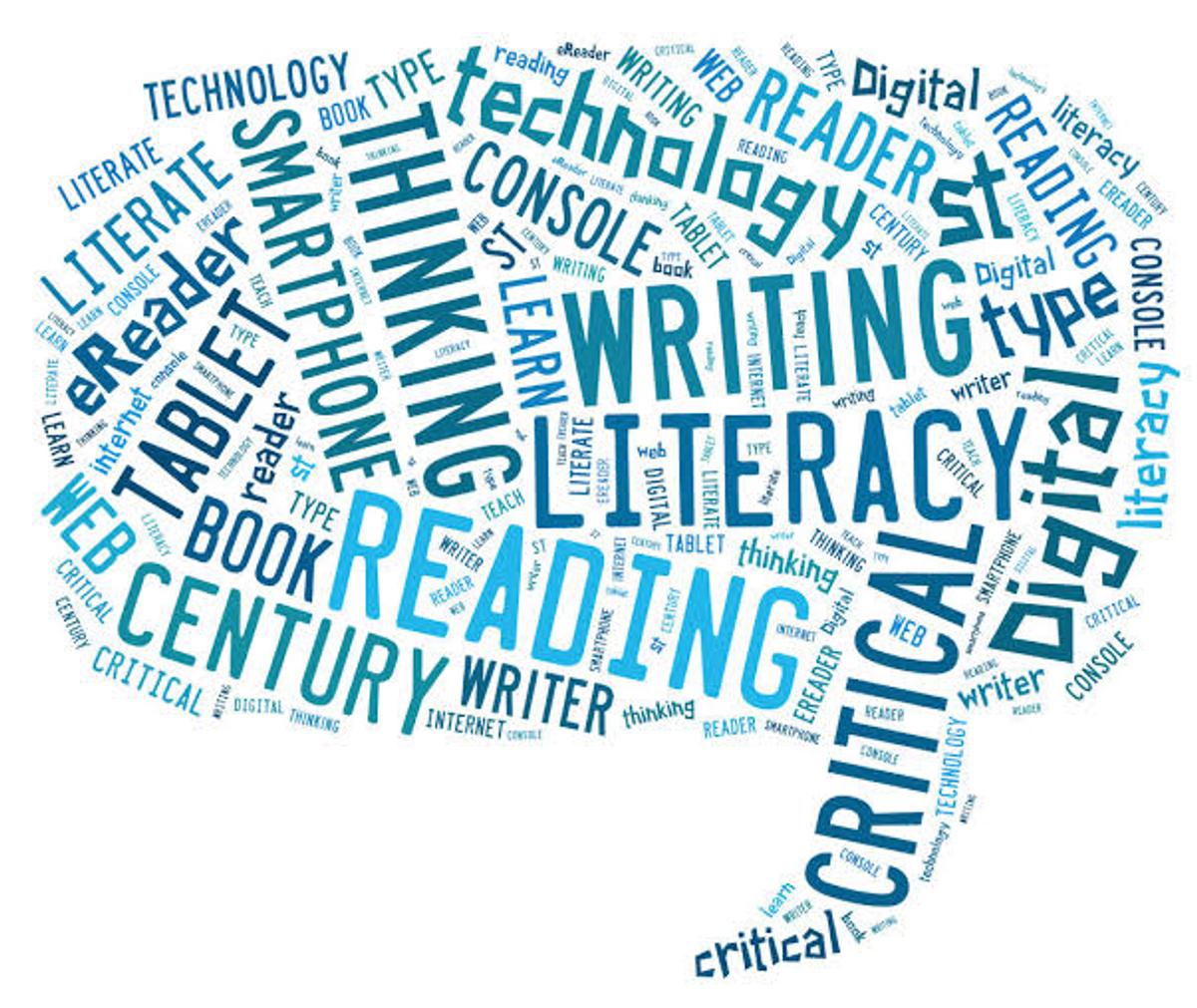

As promised, the following is the last of the information that I shared at the Literacy Parent Information Session a few weeks ago.
Tips to support writing at home
Fun things to do with your child
Reading and writing during the holidays
As I had suggested before the end of Term 1, the holidays are a great time to get into the local library and borrow books to read at home. Often various activities are scheduled over the school holiday period. ENJOY reading during the holidays. And, a reminder, St Fidelis School has subscriptions to two reading platforms:
Sunshine Online
log in St Fidelis password read123
A great way to get children to write during the holidays is to make it purposeful. Why not write a letter to friends and extended family members, put it into an envelope, add a stamp and post it in a red street-posting box?
Celebrating learning
Last but not least showcasing two information reports that deserve to be shared with you all for the great work and effort.
‘Italy’ By Jack 5/6 BZ
Can you bare these bear facts? By Micah 5/6 OS
Well done, Jack and Micah!
Italy is a semi large country located in southern Europe. Italy is known for a great soccer World Cup performance, outstanding food and some interesting wildlife. Did you know that Italy is the fifth most visited country in the world?
Sport: Italy has an outstanding sports culture. Nearly all Italian citizens have a love for soccer. In pro so far they have won 4 Fifa World cups, 2 European championships, 1 gold and 2 bronze in the Olympics. Did you know that Italy is ranked 9th in Fifa world cup points? Other than Soccer Italy has a very strong Water Polo team . They have won 7 world championships, five World Cups, 11 European championships and three World Leagues .
Food: Italy has some of the world's most favourite foods; currently it's the second most popular cuisine worldwide. Some of Italy's most beloved foods are pizza pasta and my favourite gelato. Did you know that the average Italian consumes 26 kilograms of pasta each year that's equivalent to three full grown watermelons. Italy's 2 questionably most iconic foods Pizza and Pasta have a huge age difference. Pizza was only made around 220 years ago while Pasta has been known since the 4 th century BC . Many foods are known internationally for their Italian heritage.
Wild life: Other than tasty food and skilled sports players Italy has some exotic wildlife. One of the following is the Marsican Brown Bear which lives in Central Apennine Mountain regions of Italy . The Marsican brown bears diet consists of tubers, roots, fungi, fruit, berries, insects, honey, eggs and sometimes sheep or cattle. A full grown male can grow up to an amazing 1.9 to 2 metres standing and weigh 230 kilos . Unfortunately the species is on the brim of extension with only a worrying 60 bears left in the wild . The marsican brown bears are iconic in Italian culture .
Conclusion: Italy is a very cool country featuring high standard sport Mouth watering food and intriguing animals did you know Italy is one of Western Europe's youngest countries. Maybe you'll see for yourself one day.
Introduction: Did you know that “kOaLa BeArS” are not even bears!? They’re just koalas.
Bears are some of- if not, THE downright strongest mammal(s) on earth! With just 1 swing of an arm, they can easily fold your neck! Let’s dive into the biology of these mammals!
Diet: Bears are literally just carnivorous (unlike koala bear-) uhm… They only prey on living things.
Not-so fun fact 1… Polar Bears like human flesh so much that they are CONSTANTLY on the hunt for humans they can kill & eat!
Polar Bears are super dangerous. There is literally a bear survival song that goes:
Brown=lay down
Black=fight back
White (polar bear)=say goodnight
… And 2: All bears eat their prey alive (except for animals such as fish that die in one bite). People have called the police WHILE A BEAR WAS FEASTING ON ‘EM! You’d be pretty stupid to face a bear alone.
Habitat habits: Bears live in forests and jungles where they are atop of the food chain. Speaking of food, sometimes, bears will use a large source of food (like a human alone in the woods) to train their cubs’ eating skills!
Final fact! Did you know that Bears are better parents than Guinea Pigs?
Guinea Pigs are like Tinaton, adorable menaces/psychopaths as they eat their young if they’re feeling lazy.
Meanwhile, bears are great parents, training their cub’s eating skills and don’t just abandon them for inconvenience (unlike sharks…).
Conclusion about the coercive creatures: Bears are ferocious/fierce animals that should never be underestimated, if you encounter one, RUN or use the bear survival song (Brown=lay down Black=fight back through intimidation, White= you’re done for) By the way, there’s a chance that the tips in that song don’t even work, so… You’re probably cooked either way. Stay safe from these cute, yet intimidating carnivores that have captured (figuratively and literally) the hearts of many.
Wishing you all a restful and relaxing Term 2 break.
Bernadette Parnis
Welcome to the last week of the term. It has been a long one, and I am sure lots of you are looking forward to the break. All levels 1-6 are just finishing their subtraction units and are post-assessing these now. They will also pre-assess for multiplication this week so that we can plan units for the start of Term 3.


Parents often ask me how they can support their children at home and continue to build on their positive attitude to maths. My suggestion is to make it real! Explore real-life maths with them. As we begin the holidays, whether you are heading away to somewhere warm or staying here, you will notice that day trips and movie trips all cost money. I have found giving my children an amount to use during the holidays worked a treat. They have to budget with it and work out if they want to spend it on one or two ice-creams with all the extras or spread it out over the week and settle for cheaper ice cream.
Financial math is threaded throughout the new maths curriculum from F to 6, ensuring this is part of all areas of maths. So allow your child to identify if they can afford to pay with the coins and notes they have and then if they will get any change. If able, work out how much change.
The other area to look at while on holidays is the concept of time.
From Foundation, understanding the language of time, parts of the day, length of different activities, days of the week to moving to
In Year 1, students will be able to say the time in o’clock and digital to the hour and half hour, as well as know the months of the year.
Year 2 children need to be able to determine the number of days between events using a calendar and reading the time on an analogue clock to the hour, half-hour and quarter-hour.
Year 3 students need to be able to tell the time to the 5-minute mark.
By Year 4, they are learning to solve problems involving the duration of time, including situations involving ‘am’ and ‘pm’ and conversions between units of time.
Year 5 students are expected to be able to compare 12 and 24-hour time systems and solve practical problems involving the conversion between them.
Year 6 students are expected to be able to measure, calculate and compare elapsed time; interpret and use timetables and itineraries to plan activities and determine the duration of events and journeys.
Looking at these curriculum expectations, you can see how discussing these during the holidays could help your child while putting the learning into real-life contexts. Have your child/children point out the time and work out how long before you leave, arrive home etc..
These videos are great for helping explain these as well:
In preparation for Term 3, if your child is in Year 3 to 6 you may want to help them become fluent with their table facts. One way we teach them is through this approach.
2 times tables – these are doubles - 2 of anything is double it. Most children in Year 1/2 know their doubles, so connecting these to the 2 times tables is important.
3 times tables - double plus one more – so 3 times 4 is, double 4 (8) and one more 4, so 8+4 so 12.
4 times tables - double/ double – so double 2 is 4. This helps me when I know double 6 is 12 so double 12 makes 24.
5 times tables - if I know my 10 times tables, 5 is half of 10, so I can use the 10 and half it. 5 x 6, I know 10 x 6 = 60 so 5 x 6 is half that, so 30.
6 times tables- I can use my 5 times tables and add one more, 6 x 7 is the same as 5 x 7 = 35 and one more 7 so 42, or I can use my 3 x tables and double. 6 x 7 is double 3x 7= 21 so 42.
7 times table- can be thought of as 5 x plus 2 times. 7 x 6 is the same as 5x 6= 30 plus 2x6=12 so 7x6 is 42.
8 times table is double/ double/ double. Double 2 is 4, Double 4 is 8 , so 8 x 6 is double 6=12, double 12 =24 and double 24 is 48 so 8 x 6 =48
9 times table is one less than 10 x table. If I know 10 x 6 =60, I can use this to help with 9 x6. Its one 6 less, so 60-6=54
10 times table- most children know these. It is moving the number one place to the right and zero holds the place.
Once children understand the commutative property (turn around facts), they will see that they know many facts. I suggest learning one set of table facts at a time. This is the sequence for learning the facts, although some switch the 2/4/8 and learn those in sequence as they are double/ double/ double. I ask students to practice saying the facts out of order. If they can recall the fact in less than 3 seconds, it is a goodie, and I move those aside, I look at the facts that weren’t easily recalled. These are the baddies. These are ones we need to practice. Don’t fill their heads with the goodies; they know these and now need to focus on those they didn’t know. This is where the strategies listed above may help. What will help them learn the fact? Which strategy works for them? Practice these ones.
Good Luck.
I look forward to seeing you all after the break, ready for another great term of learning.
Colleen Monaghan
SSV Interschool Sport Competition


The Coburg District Winter Interschool Sports season finished with the finals being played on Friday, 21 June 2024.
As you know, our girls' netball team finished as equal premiers in their division and qualified to compete in the finals at Coburg West Primary School. The girls won their semi-final against St Olivers but unfortunately lost to Pascoe Vale in the grand final. What a wonderful effort by the girls!
Congratulations to the girls, Ms Sargent & Ms Maddie, on a wonderful season and performances on Friday.
Year 3/4 Sport
Our Year 3/4 students will be participating in their Miniroos soccer clinics on Friday, 28 June.
Session Times: 9.30am & 11.00am


BUONGIORNO!
Salve a tutti! (Hello to everyone!)
LA GIORNATA ITALIANA
MILLE GRAZIE!! (Many thanks), to everyone who participated in last Thursday’s Giornata Italiana, including both children and staff. Listening to children’s, parents' and teachers' comments, it sounds like it was a very successful Italian Cultural Day. The weather may have been grey outside but there certainly was plenty of colour and smiles inside at St Fidelis. 😃


As most of you know, the Giornata Italiana began with a whole school sfilata di costumi italiani (Italian costume parade). This was an amazing turnout. I would like to thank everyone, including staff, who went to the great effort of either making, hiring, or looking in their wardrobe at home to find something that would fit into the Italian theme. We had gondolieri, (gondoliers) calciatori, (soccer players) cuochi, (chefs), pizzaioli, (pizza makers), venditori di gelati, (gelato stall holders), autisti di Ferrari, (Ferrari drivers) e Mario e Luigi, just to name a few. I would also like to make a special mention of a few creative costumes of the day:
Edith T in FAM for her amazing pizza costume 🍕
James B in FLW for his limone Siciliano (Sicilian lemon) costume 🍋
Arnold M in 1/2VK for his gondola e gondoliere costume
Estelle K in 5/6BZ for her Barilla pasta box costume 🍝
Stella B and Olivia M in 5/6MC for their twin venditori di gelati costumes 🍦
Samuel L in 5/OS for his personalised Nutella costume and
Leon S in 5/6OS for his overflowing spaghetti e polpette costume
Plus, the 10 Ferrari drivers that left the F1 to visit our school for the parade 🏎️ 😉
Your costumes were amazing! Grazie! 👏👏
I have included in today’s article some photos of the many taken on the day of various happenings, including the parade, the waiter’s race, the Italian placemats, bracelet making, Tower of Pisa challenge, Mona Lisa drawings, soccer skills and of course the incursion: I Tarantati, whereby Rosa e Filippo introduced the children to various Italian songs and dances including la tarantella using musical instruments such as la fisarmonica (accordion), il tamburello (large Italian tambourine), le castagnette (castanets), a man-made violino (violin) and la ciaramella (traditional Italian flute).



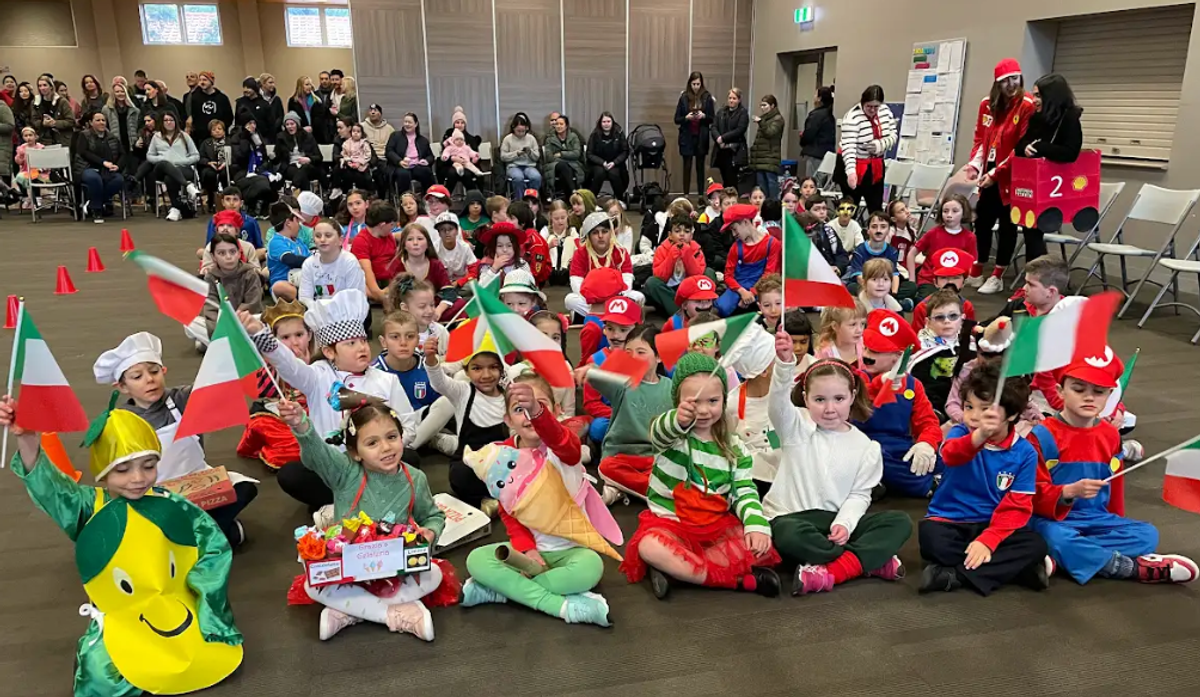









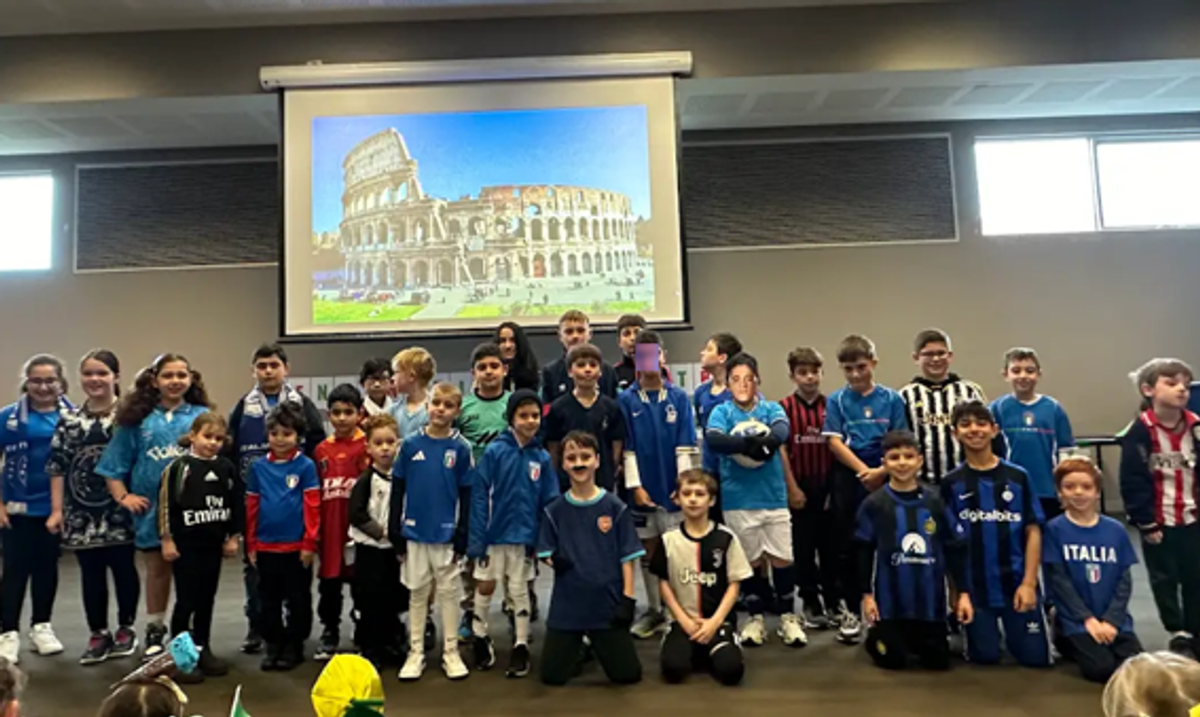


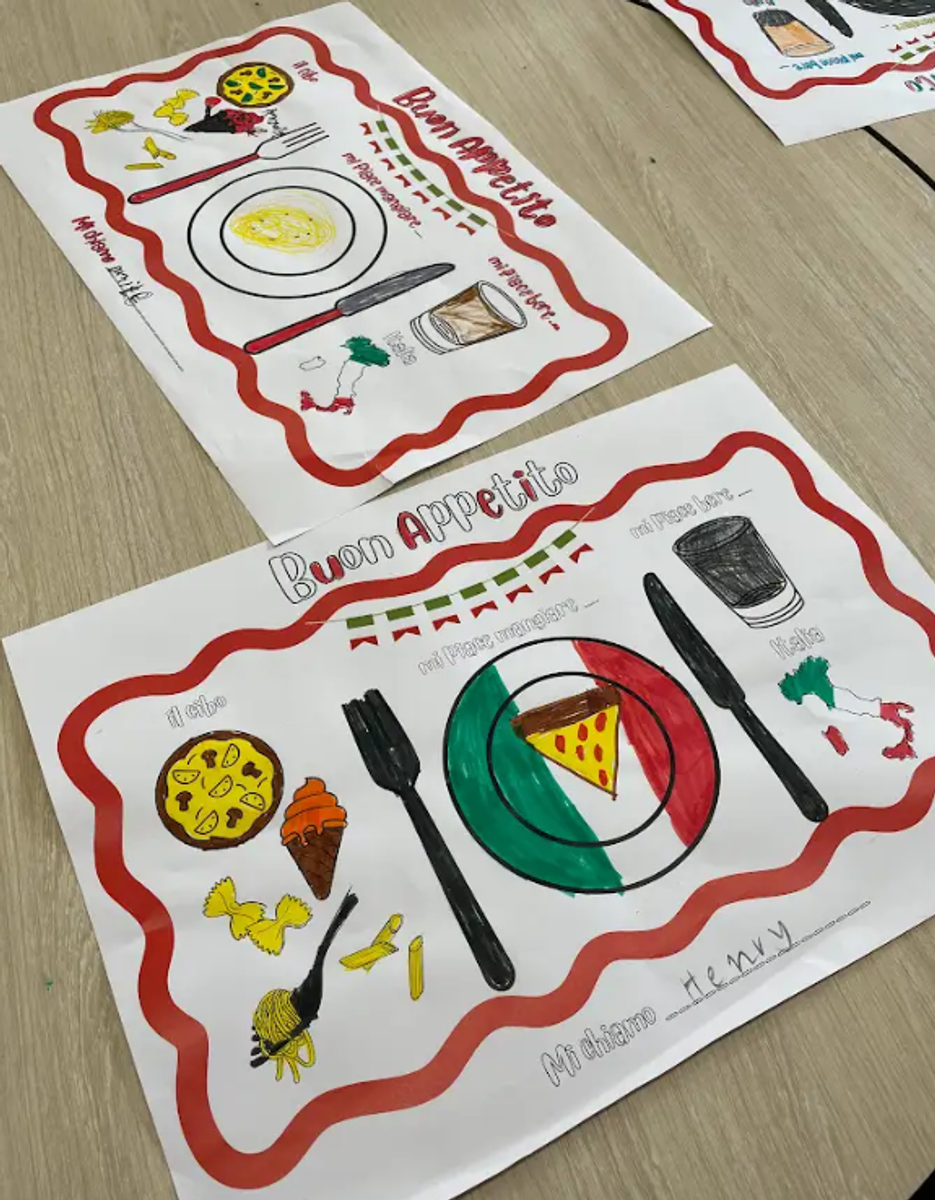



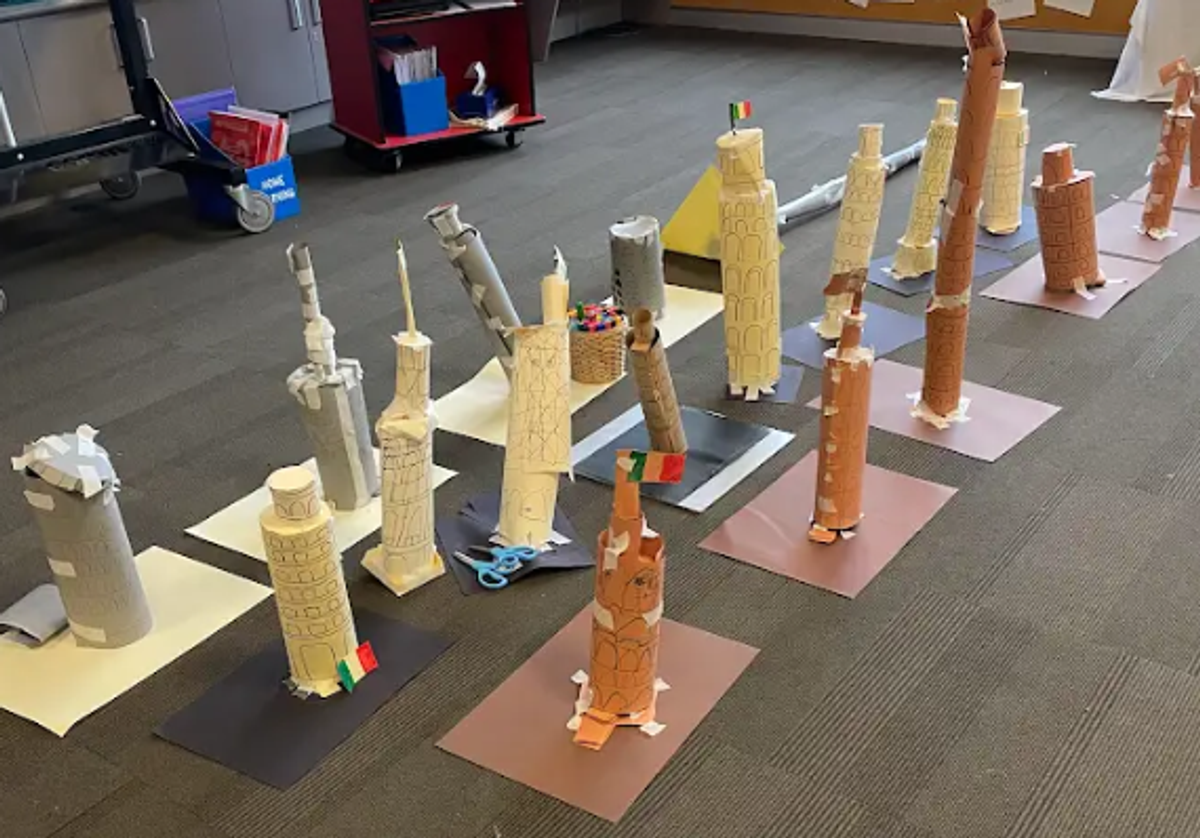

































































I hope that some of you were able to visit your child/ren’s class and see what work they have been doing in Italian. I know this was a short visit but it was just so you could get a taste of what’s happening in class and perhaps continue practising the language at home as well.
I would also like to ringraziare (to thank) the P&F for organising the pasta e gelato lunch for the children. There was a great response for orders and I know that the children that had ordered lunch were quite content with their food. Grazie! Also thank you to the families that gave their child/ren an Italian lunch from home, this was also requested as part of the day’s happenings to see which class was going to be the class with the most Italian lunches. It was a very close call by a number of grades, only a difference of 1 or 2 lunches. We ended up having an equal tie for first and since I only had one class prize, the winning class was drawn out of a hat, so I campioni del più grande pranzo italiano, (the champions of the biggest Italian lunch) were FLW, Bravissimi bambini!


EURO UPDATE:
As some of you may be watching the UEFA Euro 2024 (Soccer championships), here is an update on Italy’s match progress so far.


Gli azzurri (the Italian team), the current championship holders, won against Albania Domnica on Sunday, 16/6, 2-1.
Unfortunately last venerdì mattina - Friday morning 21/6 , 5am our time, gli azzurri, lost to Spagna with a result of 1-0.
This coming martedì, mattina - Tuesday morning, 25/6, 5am our local time—the gli Azzurri will be playing against Croazia—Croatia in a must-win match. I hope to come to school tomorrow with a smile on my dial. I wish them all the best.
In bocca al lupo! (Good Luck)
BUONE VACANZE!


I would now like to take this opportunity to wish all the St Fidelis' school community a happy holiday break. I look forward to seeing the children all ready and eager to continue learning more Italian language next term!
Until next time…buone vacanze a tutti! Have a good holiday break, everyone!
Signora Rosa 🌹